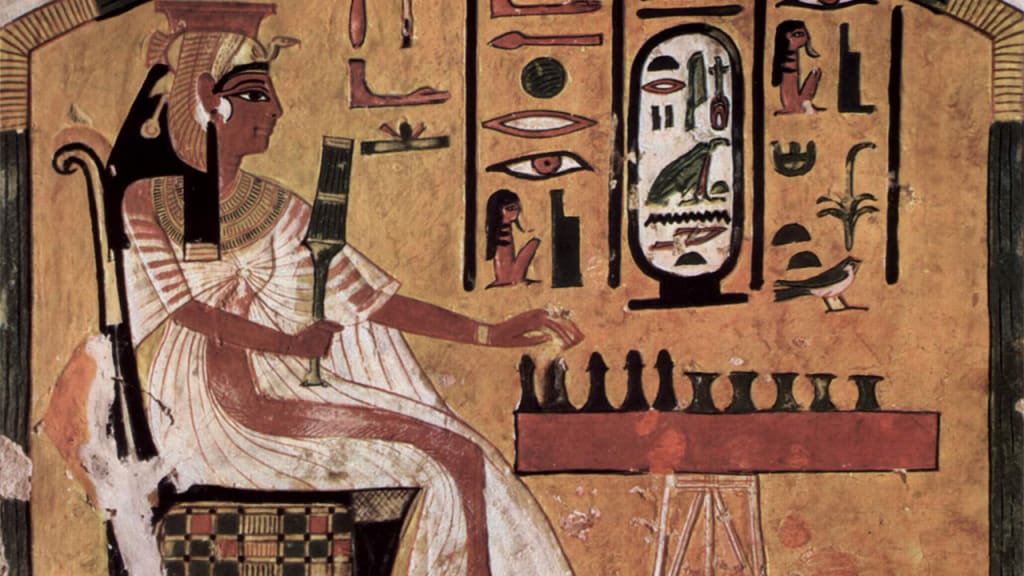Ancient Egyptian Board Games
Do you know your senet from your mehen?

When you think of board games, popular staples such as Cluedo and Monopoly might spring to mind. However, board games in some form or another have been played and enjoyed since the Neolithic period (10,000-4,500 BCE).
In ancient Egypt and the near East, most board games were played with throwing sticks or 'knucklebones' which were later used alongside (or instead of) the dice we commonly use in modern games. The physical game boards or boxes were made from a wide variety of materials: from beautifully carved wooden or ivory boxes, a pottery-like material called faience, or even scratched into the dirt on the floor like we would draw a noughts and crosses board in modern times.
Additionally, representations of such games are found in temples, tombs and even papyri from all dynasties in Egyptian history; which has helped archaeologists understand not only what these games were, but who played them and why. Historians believe that Egyptians loved these games of chance, as it proved their fate was in the hands of the Gods.
Let's take a look at the four main board games archaeologists have uncovered from the sands of ancient Egypt.
1) Mehen:

One of the oldest games in this list, Mehen was played on a board that was coiled in the shape of a serpent. The game took this particular form as it was meant to represent the snake god (also called Mehen) which means 'coiled-one'. In mythology, this serpent would form a protective barrier around the god Ra as he entered the underworld each night. The aim of the game, was to get your playing piece (either a lion or lionesses head) to the centre of the board before your opponent. The Egyptians believed that by reaching the centre of the spiral, you symbolically joined Ra on his barque (boat) and journeyed into the afterlife with him.
2) Hounds and Jackals (or 58 Holes):

This game has astounded historians and archaeologists alike, as they don't actually know what this game was called in ancient Egypt or how it was played. Flinders Petrie, a famous archaeologist, first discovered the board and named it '58 holes' as the board had, you guessed it, 58 holes. However, when Howard Carter later found a board complete with pin-like pieces beautifully carved with the heads of hounds and jackals, the game was given it's more recent and common name. From the shape of the track on the board, archaeologists believe both players had to 'race' around the track until they reached the eternity symbol known as 'shen'.
3) Aseb (or Twenty Squares):

Aseb is known as the Egyptian form of an earlier Middle Eastern game commonly known as 'The Royal Game of Ur' and would have been played in Egypt during the Middle Kingdom. Aseb was a simpler and quicker form of Senet (see below) and would often be found on the reverse side of Senet game boxes. The aim of the game was to get your playing piece to the other side of the board as quickly as possible. It seems that on most boards, the 4th, 8th and last squares of the game board would be marked by different symbols that may indicate a 'miss a turn' chance similar to modern games.
4) Senet:

Probably the most famous of all Egyptian board games and one of the most popular and long-lasting games played in all of Egyptian history. Evidence of senet can be found from the early Pre-Dynastic period right up until the Late Period. There was even a senet game board found in Tutankhamun's tomb! The senet game board consisted of 3 rows, each with 10 squares. The players would move their pieces in a 's' shape around the board and the first to the final square would win. In the picture above, you can see where the pieces would be kept in the little drawers underneath the box. This would make this game easy to play and very portable.
Senet and Mehen were found exclusively in Egypt, with similar games appearing in neighbouring areas like the Levant. However, games such as 20 squares or Hounds and Jackals were found as far away as Turkey and India!
In more modern depictions, illustrators and authors have used these archaeological discoveries to come up with stories and tales to educate young historians about the fascinating world of ancient Egypt.
Can you spot 3 of the above mentioned games in the image below?

About the Creator
T. Freya Taylor
Im Freya, archaeologist, teacher and proud Ravenclaw and officially a published author (check out ‘The Mummy’s Curse: Secrets and Senet!) I’m fuelled by my passion for ancient history, culture and mythology, especially ancient Egypt.






Comments
There are no comments for this story
Be the first to respond and start the conversation.